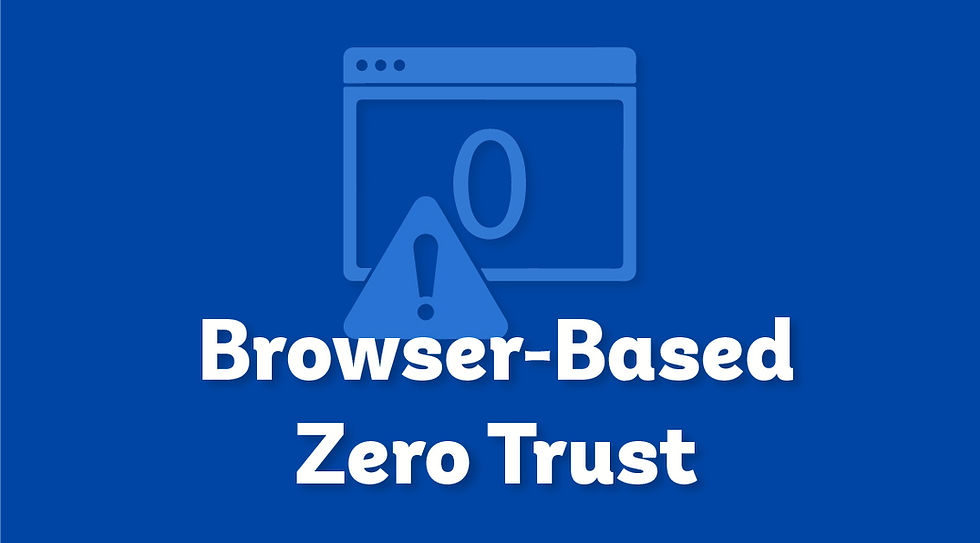
Introduction
Remote and hybrid work has become the norm for modern enterprises. According to Verizon’s 2024 Mobile Security Index, 92% of organizations support some form of remote connectivity—a statistic that emphasizes just how critical web browsers have become. These browsers are now the primary gateways employees use to access sensitive data and applications, but that also makes them prime targets for cybercriminals.
To protect these critical access points, Chief Information Security Officers (CISOs) and security leaders are turning to zero trust frameworks. A key component of these frameworks is browser-based security—a way to isolate and secure browser sessions to defend against threats like phishing, malware, and ransomware.
Browsers: A New Defensive Frontline
As organizations migrate to cloud-based applications, web browsers become essential tools for getting work done. However, their ubiquity also makes them attractive targets.
• Rising Phishing Incidents: The Anti-Phishing Working Group reported nearly 5 million phishing attacks in 2023, the highest on record.
• Ransomware Attacks on the Rise: The 2024 Data Breach Investigations Report by Verizon found ransomware to be a top threat in 92% of industries, with 32% of breaches involving ransomware or extortion techniques.
Browser-based isolation plays a crucial role here: by containing and neutralizing threats before they interact with the operating system, enterprises can drastically reduce their attack surface. This proactive approach is especially important as attackers increasingly use phishing as an entry point for more destructive campaigns.
Why Secure Browser Operations Now?
Threat actors are constantly refining techniques like code injection, cross-site scripting (XSS), and forgery attacks to exploit browser vulnerabilities. These tactics can give attackers unauthorized access, allowing them to steal data, hijack user sessions, and embed harmful scripts into trusted websites.
A secure browser environment mitigates these threats through:
1. Session Isolation: Keeps malicious code from ever touching the user’s device or the network.
2. Input Validation & XSS Filters: Blocks harmful scripts from executing within the browser.
3. Authenticity Verification: Uses digital certificates and HTTPS protocols to confirm that websites are legitimate.
Such protections have become non-negotiable with more employees working outside traditional office environments. The 2024 Mobile Security Index found that 83% of organizations have employees following hybrid work models, making robust remote access security critical to successful zero trust operations.
Key Benefits of Browser-Based Security
Modern, secure browsers are designed to integrate advanced defensive capabilities directly into the browsing environment. Here are some of the top advantages:
1. Protecting Data in Transit:
• Ensures sensitive information remains encrypted throughout its journey, reducing the risk of interception or man-in-the-middle attacks.
2. Enhancing Phishing Prevention:
• Anti-phishing filters verify website authenticity and block suspicious URLs, minimizing credential theft.
3. Enabling Malicious Content Rendering:
• Built-in sandboxing detects and neutralizes harmful scripts or drive-by downloads, preventing them from executing on user devices.
4. Eliminating the Need for Traditional VPNs:
• Direct-to-resource access improves performance and scalability, especially for globally distributed workforces.
With 62% of authentications now occurring through mobile devices and non-traditional operating systems (2024 Mobile Security Index), maintaining a secure browsing environment has never been more urgent.
The Future of Browser-Based Security in Zero Trust
As zero trust frameworks evolve, browser-based security will be central to preventing the spread of ransomware, phishing, and other sophisticated attacks. Expect more AI-driven enhancements, including:
• Behavioral Analytics: Early detection of anomalous activities, enabling proactive threat mitigation.
• Sandboxing and Real-Time Malware Detection: Identifying and containing malicious scripts or code before they infiltrate networks.
• Continuous Validation: Ongoing, adaptive checks that align with zero trust principles, ensuring no user or device session is trusted by default.
Take Action to Strengthen Browser Security Now
CISOs and security teams must prioritize implementing browser-based security solutions that align with zero trust architectures. By doing so, they can significantly reduce the risk of falling victim to the ever-increasing threats of phishing, malware, and ransomware.
Key Steps:
1. Audit Current Browser Security – Identify existing vulnerabilities and align them with zero trust protocols.
2. Implement Browser Isolation – Block malicious code at the source, preventing it from reaching end-user devices or critical systems.
3. Leverage Advanced Threat Detection – Use AI-driven tools to spot abnormal behaviors and isolate threats in near real-time.
4. Ensure Encryption and Identity Verification – Protect data in transit with SSL/TLS and enforce strong identity and access management (IAM).
Conclusion
Browser-based security is no longer a nice-to-have—it’s an integral part of any robust zero trust strategy. Given the surge in remote work, rampant phishing attempts, and rising ransomware incidents, organizations need proactive, browser-focused defenses. By isolating sessions, validating website authenticity, and monitoring for suspicious behaviors, enterprises can safeguard their most critical assets and ensure business continuity in a constantly evolving threat landscape.
Ready to Enhance Your Zero Trust Framework?
Start by evaluating your current browser security tools and policies. Implement isolation, integrate AI-based threat detection, and maintain strict access controls. These measures lay a strong foundation for a safer, more resilient environment—where employees can work securely from anywhere and access the resources they need without putting your organization at risk. Contact Allendevaux and Company today to learn how our bespoke cybersecurity solutions can take your Zero Trust strategy to the next level.


Commentaires